There are so many blogs out there (600+ million to be exact). Hence the need for developing your own blog style, to set yourself apart from the crowd in your niche. From starting a blog and honing in on your own blog writing style (over time), to developing a more clear blog style guide to cover things like formatting, grammar & tone—it’s never been more important to have a clear style.
Plenty of blogs have similar content, within the same niche. They might have the same types of product roundups, tutorials, or advice posts.
So what makes readers pick one blog over another? Why do readers keep coming back to some blogs again and again—subscribing to the email newsletter, buying their products, even recommending the blog to their friends—while other blogs languish unread? Often, it all comes down to the blogger’s style.
When there’s very little to distinguish several different blogs in terms of the information being presented, readers will opt for a blog that has an engaging tone and voice. This is what keeps them coming back for more.
In this guide, we’re going to dig into what exactly blog style is, then discover how you can develop a strong blog writing style. We’ll end with some tips (plus a free blog style guide template) you can use to create your own blog’s style guide.
How to Develop a Blog Writing Style (Create a Blog Style Guide) & 7 Examples to Learn From
- What Exactly is Your Blog Style?
- Examples of Great Blog Styles (from 7 Different Bloggers)
- How to Develop Your Blog Style: 6 Powerful Tips
- Creating a Style Guide for Your Blog Content: Free Template
Disclosure: Please note that some of the links below are affiliate links and at no additional cost to you, I’ll earn a commission. Know that I only recommend products and services I’ve personally used and stand behind. When you use one of my affiliate links, the company compensates me, which helps me run this blog and keep my in-depth content free of charge for readers (like you).
Want My Free Blog Style Guide Template?
Grab my free template (in Google Doc format) and define your unique blogging style today.
"*" indicates required fields
Ready to get started on developing a blog writing style for yourself? Let’s do it.
What Exactly is Your Blog Style?
Your blog’s style is how you present your content. It can include visual aspects of your brand (like color palettes, font choices & layout elements)—but in this guide, we’re focusing primarily on developing your blog writing style, tone, formatting and the like.
Your writing style might be:
- Warm and friendly
- Silly… or even a little zany
- Calm and collected
- Chatty and intimate
- Straightforward and factual
- Outspoken and forthright
- Impassioned
All of these styles could attract certain types of readers. They might also put off some readers—but that’s okay! Your blog won’t appeal to every single reader out there; it shouldn’t. Instead, you want your style to be a good fit for the type of audience you want to attract, and the brand you’re aiming to build.
Examples of Great Blog Styles (from 7 Different Bloggers)
One of the best ways to understand blog style is to look at how different bloggers write. We’re going to dig into a few very distinctive blogs and see how they do things.
1. RyRob (My Blog)

As a veteran blogger of over 10 years now, I’ve developed a very particular blog writing style that’s casual, light, authoritative, irreverent, fun and unashamedly silly at times. For example, see how I position my tone around the blogging advice you can expect to get from me, as spelled out simply on my homepage: “No tricks. No hacks. No bullshit.”
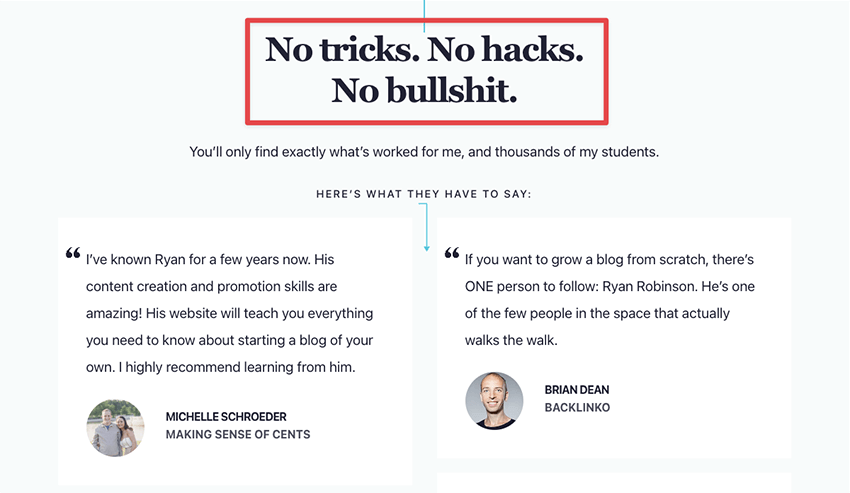
On the visual style front, I’ve leaned into my favorite fonts (which I talk all about in my blog layout guide) and color scheme that emphasizes blues and grays. Here’s what my typical blog header section looks like:
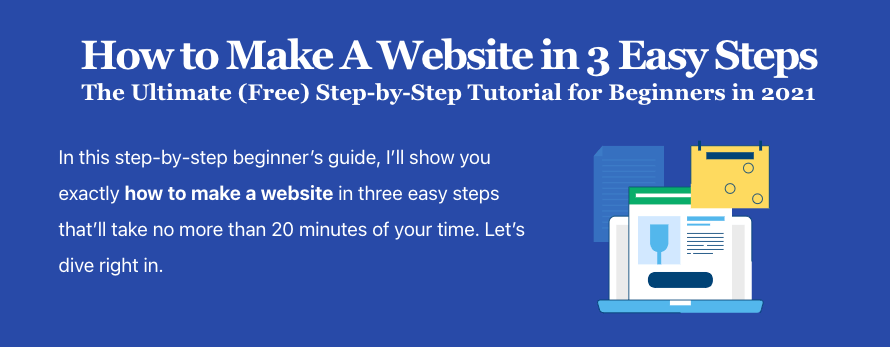
From a layout style perspective, a couple of years ago I redesigned my entire blog. Along with that project, I also decided to remove my blog sidebar to help with Google PageSpeed performance, and this decision later turned into a really positive one in terms of the influence it had on my overall blog style. I was able to move into a more modern, sleek, lightweight and reader-friendly view for my WordPress blog that has a clear look like I’m properly established in my niche.
Today, I’m moving very intentionally away from just being a blogger—and into the arena of offering tools. I’m building free blogging tools for my audience, that solve the problems I had when I was just starting out:
- Free Keyword Research Tool: See monthly search volume, difficulty and get dozens of keyword ideas to blog about.
- Blog Title Generator Tool: Get dozens of free AI-powered blog title ideas & content topics to write about.
This is with the goal of providing value to my readers & evolving my blogging style into an even more authoritative space.
2. Cup of Jo

Cup of Jo, by influencer Joanna Goddard, is a hugely popular lifestyle blog. Posts have a chatty, friendly, very informal tone. Here’s an example, from Joanna’s post Have a Yummy Weekend:
Tomorrow we’re going to see our friends’ teenagers in their school play! I LOVE school plays (remember this funny SNL skit?). Hope you have a good one, and here are a few links from around the web…
3. Smart Passive Income

Smart Passive Income is Pat Flynn’s long-running business blog. He writes in a straight-talking, honest way that doesn’t sugarcoat the truth – but that offers lots of inspiration and positive advice aimed at encouraging people to take action.
Here’s an example, from How to Get Into Freelancing (And Get Your FIRST Client!):
And when you’re first starting out, freelancing is the number one way to get started online. It’s not passive income, which is an important thing to understand. Freelancing is definitely not passive; it’s super active. If you don’t do the work, you’re not going to get paid. But if you are dedicated and put in the effort, freelancing is a great way to get your foot in the door of an industry or niche you’re interested in. It’s, quite simply, a great way to get started in business.
4. Copyblogger

Copyblogger, founded by Brian Clarke, delivers useful advice to writers in a friendly but authoritative way. There’s plenty of room for authors to inject some personality – but posts are fairly tightly written, without wasting space on fluff or filler.
Here’s an example, from Sonia Simone’s post The Betty Crocker Secret to an Email Marketing Strategy People Enjoy:
Email newsletters (curated content, along with what’s new in your business, what’s the latest promotion, what fresh and exciting offers can you make to your customer, etc.) are an excellent tool. But they’re 1,000 times better when they kick off with a terrific autoresponder.
5. IttyBiz

IttyBiz’s founder Naomi Dunford writes in a chatty, friendly, way: imagine her as your cool older cousin, giving you business advice over a few drinks. Her posts are packed with good advice for small business entrepreneurs, but they’re also full of voice and character.
Here’s an example, from Newbie Week: What do I need to get started?
Ok, people. Now it’s getting good. This is where we start getting paid. You need a page indicating how a person could give you money, should they find themselves so inclined.
6. Gizmodo

Gizmodo is a news-focused site, covering tech, gaming, science, spaceflight, and more. Its style is direct and factual, while being unafraid to offer an opinion or angle on news stories.
Here’s an example, from Twitter’s Notifications Keep Breaking in Wake of Elon Musk’s Mass Layoffs:
Twitter did not respond to a request for comment late Monday. Gizmodo will update this article if we hear back. But given the fact that Twitter reportedly fired its entire communications team, we’re not going to hold our breath.
7. WPBeginner
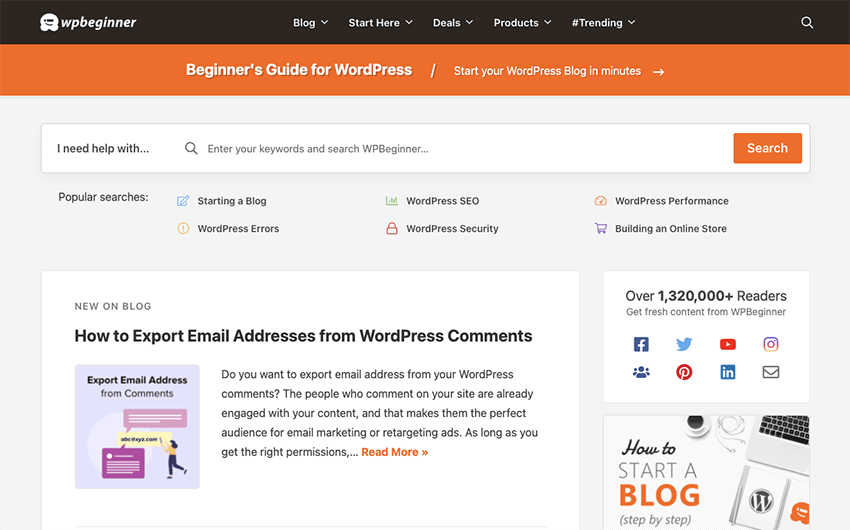
WPBeginner offers tutorials and “best of” roundups on all things WordPress related. Posts are straightforward and practical, with a focus on simple, plain, informative writing. There are also lots of links to related posts on the blog, where those offer extra help or further context.
Here’s an example, from How to Add Featured Video Thumbnails in WordPress:
First, you’ll need to install and activate the plugin. If you need help, then please see our guide on how to install a WordPress plugin. After activation, there are a few settings to configure. To get started, go to Settings » Really Simple Featured Video.
Want My Free Blog Style Guide Template?
Grab my free template (in Google Doc format) and define your unique blogging style today.
"*" indicates required fields
How to Develop Your Blog Style: 6 Powerful Tips
How can you develop your own unique and attractive blogging style? Here are a few things to try—and I recommend making a copy of my blog style guide template to work with alongside this advice.
1. Read Lots of Other Blogs and Notice What Works
Hopefully, you’re already reading at least a few different blogs on a regular basis. Next time a new post pops up in your inbox or feed reader, take a few extra minutes when you read it to notice what’s working well. Take a peek at these blog examples, while you’re at it.

As you’re evaluating a blogger’s style, take note of how you feel when you’re reading.
- Perhaps the blogger does a great job of grabbing your attention in the introduction.
- Maybe you laughed out loud at their exaggerated descriptions.
- You might simply have found it an easy, engaging post to read.
Try to pinpoint why you feel certain emotions—or have a particular thought about the blogger while you’re reading—is it their careful use of structure, their spot-on word choices, entertaining tone, or something else?
2. Think About What Blog Post Structures You’ll Use
Some blogs are known for the type of content they create. For instance, here on RyRob, I publish a lot of in-depth guides and how-to’s. You might enjoy a blog that’s full of unbiased reviews, funny listicles, or some other type of content entirely.
On a completely different page, here’s an example of prolific author Seth Godin’s blog and how his minimalist, short-form writing style takes shape:
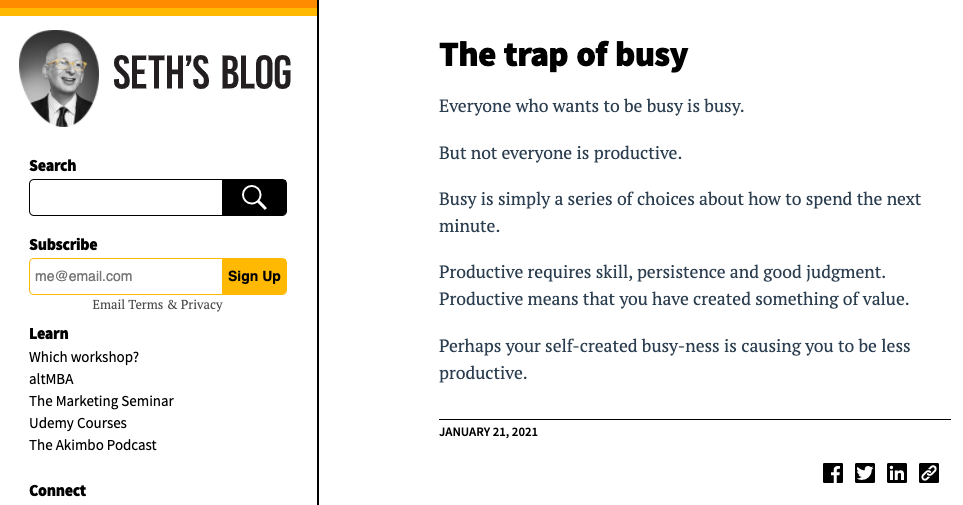
As you start to develop your own blogging style, think about what blog post structures you want to use. You might like to try out a few different ones to see what you enjoy writing—and what seems to resonate with your readers.
3. Keep Your Paragraphs Short
Blog posts are read on screens—and increasingly on tiny mobile screens. To make your posts as easy to read as possible, keep your paragraphs short. (Plenty of book blurbs on Amazon are good examples of this.)
Short paragraphs also help you to write in a more informal style, rather than an academic style or as though you’re writing a business report. This suits most bloggers and readers well.
4. Be Engaging and Conversational
One of the wonderful things about blogging is that there’s a real connection and intimacy between the blogger and the reader, just like there is on social media. You could write a post in the morning, upload it in the afternoon, and have a dozen comments by the evening.
You’re not writing an eBook that might take a year or more to be published—or even an article for a magazine that won’t come out for several months. Make the most of the advantages of the blogging medium to engage with your readers in a conversational way. That might mean sharing little snippets about your life, using “you” to talk to the reader, or asking questions and encouraging readers to leave their answers in the comments.
5. Try Out Different Tones: Then Pick One To Stick With
When you’re trying to hit on the right blogging style, it can help to try out different tones. You might draft a post with a deliberately argumentative and forceful tone, then try it out with a much calmer, more positive tone. See which one feels more like “you”.
In the early days of your blog, I think it’s fine to publish pieces that vary a lot in tone. As you establish your target audience and your brand, though, you’ll want to pick one tone to stick with—at least for the majority of the time—in all your content marketing. This should help you to keep readers and build a successful blog.
6. Make Sure Your Style Fits With Your Broader Brand
It might seem obvious, but your writing style does need to fit in with your brand as a whole. You might have a favorite digital marketing blogger who has a fantastic, funny, swear-heavy blogging style… but you probably won’t want to emulate that if your brand is all about calm, gentle parenting!
If your homepage looks very sedate and professional, readers will expect your writing style to be similar. If your blog design includes lots of bright, brash colors, then they’ll expect a more dynamic writing style. Similarly, if you have a podcast, readers will expect you to have a similar “voice” on your blog to your voice on the podcast.
Tip: You can easily change WordPress themes if your current website design isn’t a great fit for the blog writing style and brand you want to develop, or figure out which WordPress plugins can extend your functionality to get the desired look & feel.
Creating a Style Guide for Your Blog Content: Free Blog Style Guide Template
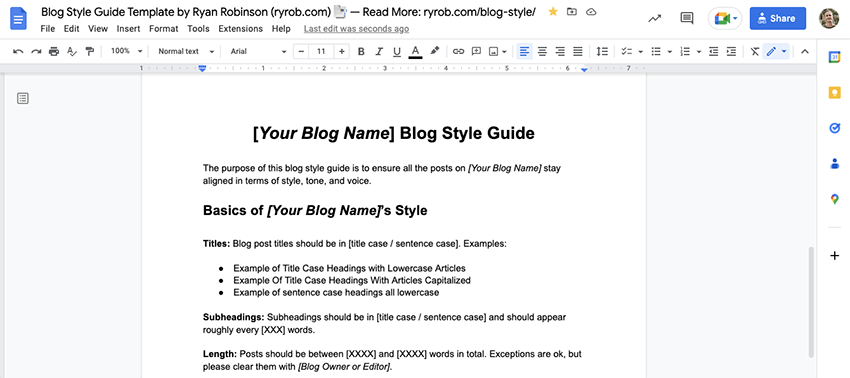
A style guide is a document that helps writers to create consistently high-quality content. If you have guest bloggers writing blog content for you—or if you work with freelance writers, then it’s a really good idea to put together a simple style guide to keep everyone on the same page. Start with my free template below.
Even if you’re the only writer, it’s still useful to have a style guide.
It can help you stay consistent on the small details (like whether you prefer to write numbers as “three” or “3”) and can also prompt you to remember the slightly bigger details – like the way you like to end each post with a call to action, or the way you always include at least one personal anecdote in every post.
This provides a better user experience for your reader and can even help with your on-page search engine optimization, if you include details in your style guide about working keywords and internal links into your posts.
Want My Free Blog Style Guide Template?
Grab my free template (in Google Doc format) and define your unique blogging style today.
"*" indicates required fields
Basics to Cover in Your Blog Style Guide
It’s up to you how you put together your style guide, but some basics you might want to include are:
- Which heading format do you use on your blog? (Title case, sentence case, something else?)
- Roughly how long are your posts, generally?
- How do you use subheadings – and how frequently? Do you use title case or sentence case for your subheadings’ capitalization? Do you aim to include keywords in subheadings? (This can help with both your on-page SEO and your overall blog SEO strategy.)
- What language are your posts written in? (If the language has variants, specify which: e.g. US English vs UK English.)
- Specific words that you like to spell or format in a particular way, e.g. “step by step” vs “step-by-step”.
- Whether you use jokes and humor or not (or perhaps you only use these in certain types of post).
- How do you present and attribute quotes within your content?
- Terms to avoid due to potentially racist or sexist connotations (e.g. using “blocklist” instead of “blacklist” or “person hours” instead of “man hours”).
- How you use emojis (maybe you never use them, or only use a few classic ones like the smiling and winking emojis – or perhaps you always include emojis in your posts).
- How are images used within your content? Do featured images always appear before the text or do you have a paragraph of written content first? (If you’re not covering this in other documentation.)
- How many internal (or external) links should appear in your content?
You can also dig into finer details of your blog writing style, like:
- Whether you use the Oxford comma (serial comma) in lists.
- What type of dashes you use (the em-dash or en-dash).
- How you format a table of contents, in posts long enough to need one.
With some blogging niches, you might also include specific information on industry terms or jargon. For instance, a fashion blog’s style guide might cover whether to use off-the-rack or off the rack, and may even conform to some special style based on your blog’s name.
Your style guide doesn’t need to be perfect from day one! In fact, most style guides will get added to over time, as you come up with questions or different ways of doing things.
Free Resource: To make it easy for you, I’ve created a blog style guide free template that you can use. Just make a copy of that document, then fill in the details for your own style guide.
Ready to Develop Your Blog Writing Style?
The best things you can do to develop your blog writing style are to read lots of other blogs in your niche and to write plenty of posts for your own blog.
Pay attention to what you like and what works—in other people’s writing and in your own—and you’ll soon find yourself getting a good handle on your personal writing style.
If you haven’t yet got your blog up and running, check out my start a blog guide. If you’re already blogging, then use my 10 blog templates to write your posts easier than ever before—leaving you free to focus on your style.
Want My Free Blog Style Guide Template?
Grab my free template (in Google Doc format) and define your unique blogging style today.
"*" indicates required fields

Hey Ryan!
Nice content. Thank you for breaking down how to create a blog writing style that will help me to stand out from the competition.
You’re welcome, Kristine! 🙂
Thanks bro, really helpful
You’re welcome, Francisco! 🙏
This post is quite detailed and worth a read. It has all the information to write a blog.